Graphics by Aimee Crane, words by Sarah Schlieder
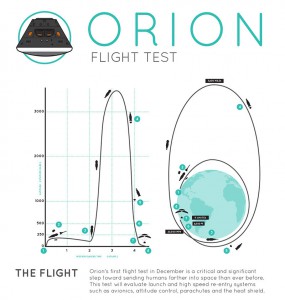 Orion is launching December 4 on its first test flight. This launch involves more than just a rocket that goes WOOSH! Orion will reach a height of 3,600 miles—15 times higher than the International Space Station—and orbit the Earth twice during the 4.5 hour mission. Want a closer look at what will take place during flight? Here are the eight things you can expect to see on Orion’s first flight.
Orion is launching December 4 on its first test flight. This launch involves more than just a rocket that goes WOOSH! Orion will reach a height of 3,600 miles—15 times higher than the International Space Station—and orbit the Earth twice during the 4.5 hour mission. Want a closer look at what will take place during flight? Here are the eight things you can expect to see on Orion’s first flight. 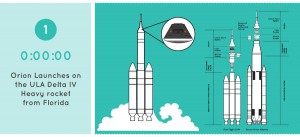
Launch
It’s going to be loud. It’s going to be bright. It’s going to be smoky. Engines are fired, the countdown ends and Orion lifts off into space atop the United Launch Alliance Delta IV Heavy rocket from the launch pad at Cape Canaveral in Florida.
Exposure
It’s time to fly! The protective panels surrounding the service module are jettisoned and the launch abort system separates from the spacecraft.
Orbit 1 is complete! The upper stage will now fire up again to propel Orion to an altitude of 3,600 miles during its second trip around Earth.
Separation
It’s now time to prepare for reentry. The service module and upper stage separate so that only the crew module will return to Earth.
Orientation
Orion’s first flight will be uncrewed, but that doesn’t mean we can allow Orion to return to Earth upside down. This test flight will help us test the control jets to ensure that they can orient the capsule in the correct reentry position.
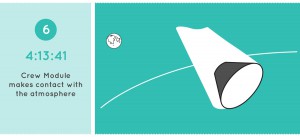 Heating
Heating
Things are heating up as Orion slams into the atmosphere at almost 20,000 mph and encounters temperatures near 4,000 degrees F. 
Deploy
After initial air friction slows the capsule from 20,000 mph, Orion will still be descending at 300 mph—too fast for a safe splashdown. A sequence of parachute deployments will create drag to further slow the spacecraft to a comfortable 20 mph.
Landing
Orion will splashdown in the Pacific Ocean off the coast of Baja California, where it will be recovered with help from the United States Navy.
Orion’s first flight has been successfully completed. Next step: deep space.


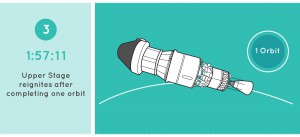
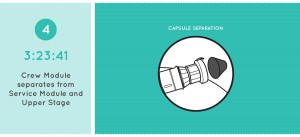

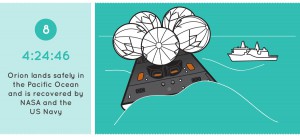
An awesome play-by-play! Can’t wait to watch the launch in person!
Jeb is getting impatient!
Great job keeping everyone updated on mission details! Thank you. It will be wonderful to see it fly!
> The service module and upper stage separate so that only the crew module will return to Earth.
Does this mean everything else is left in orbit? If so, what will happen to those parts? Will they be used in the future?
The service module/Delta IV upper stage will re-enter and mostly burnup with any remaining fragments hitting the Pacific Ocean well away from the capsule.
Hello from Germany.
I am interested in spaceflights since Mercury-times, when I was a child. I can read nowhere, if Orion is a single-use spaceship. Ore can it be used several times?
Thomas Krenz,
Berlin – Germany
Orion could theoretically be reused with a replacement of the heat shield, but current plans are for each spacecraft to be used only once. This is the same situation as back in the 60s, when the previous “capsule”-type spacecraft were in a similar situation. (Indeed, the Gemini spacecraft used for the unmanned Gemini 2 mission was refurbished, equipped with a new heat shield, and re-flown for a test flight of the proposed, but never operated, US Air Force “Blue Gemini” spacecraft, in the only re-use of a flown spacecraft before 1981!)
We can hardly wait. I got our LTT’s today and we will be at the Saturn 5 viewing area for the launch of Orion on Dec 4th…its going to be AWESOME
I haven’t seen anyone talk about video and sound during the launch. Are there cameras interior and exterior that the public will be able to watch?
Thanks
Go you good thing !!!!!!!!!!!!!!
If it looks like a rocket and roars like a rocket. It’s a rocket.
Just been watching the video regarding the upcoming Orion flight. Does the presenter think he’s taking to 12 year old’s? Surely to heavens NASA learned about that radiation belt over 40 years ago and surely NASA must have learned something from their flights to the moon.
I’m trying to get excited but this all strikes me as though their going back 40 odd years. What’s changed?
Completely agree. What is the significance of this flight?
Will the chairs be weighted to 225lbs each to simulate the weight of 4 Astronauts for an acurate flight dynamics simulation.
doubtful, most of this capsule is just fluff. The heatshield is about the only real thing on it.
I was wondering the same thing more space junk to get rid of in the future…….
When Orion lifts off and starts it roll program will the launch vehicle head in a southeasterly, easterly or even northeasterly direction like some of the shuttle launches did?
Can’t wait, I following it since you NASA annouced Orion. “Space, the final frontier.”- Star trek
What is the best place from which to watch the launch? Are tickets needed?
I think the entire ship should be what is pictured on the top of this page, not just the Apollo style of space pod.
Back to the sixties and my youth when I and millions followed the Apollo missions to the moon.
Hi Bob, my sentiments exactly. I mean, I’m not looking for any “Star Trek” action in our life time but to return to this earth by landing in the sea again. Come on, what’s the score here?
Conspiracy theorist are having a field day with radiation testing of the electronics.
Get this straight. The Apollo crafts used rope core memory early transistors and in today’s terms Integrated circuits that were gigantic in its construction compared to today’s mass integration semiconductor technology. These early days circuits were a lot less prone to radiation because of its shear size of material to construct the circuits and transistors. Modern electronics in this environment except for ground testing and space probes is still fairly unknown.
This spacecraft system is inefficient since most all of it is just wasted and thrown away after a mission. A whole new rocket and the other rocket stages have to be rebuilt, such as the service module and the earth departure stage rocket for another mission. This is not the way to do things. What is needed is reusable spacecraft systems that can refurbished in space in a space garage refurbishing facility in low earth orbit. When spaceships return they inter the garage to be made ready for another mission. After all, the United States military does not throw away it’s aircraft and build new ones after each mission do they.
Why is the figure out of proportion? The earth is about 4000 miles in diameter. The figure shows the satellite at maybe 5000 miles from the earth’s surface.
Earth’s diameter ~ 8000 miles; orbit looks like ~ 10 000 miles from surface.
Blast me off
Why do we still mess around with primitive rocket propulsion when we have been also secretly using anti-gravity and zero point technologies for decades? Thomas Townsend Brown… Tesla… technology so far beyond rockets.
Yeah. Beam me up, Scotty!
I think more funding should be brought back to our space program.to bring better tech and advancement.we should never have never let our wonder of space exploration fade at any cost.I think it’s needed Badly. back in the original program the public had a common cause to unite for and hope together the key word together